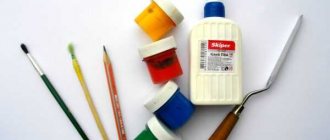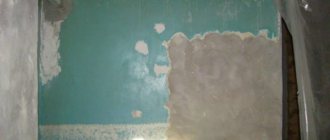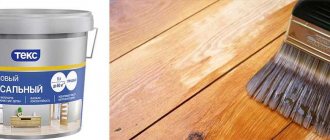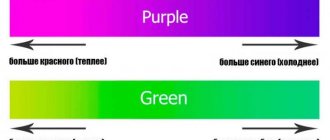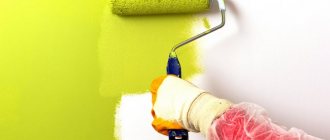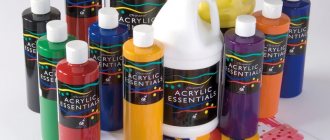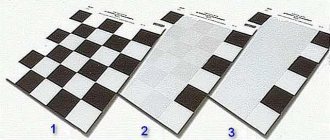The color for acrylic paint is usually selected when there is no ready-made material of the desired shade on sale. By correctly mixing a white base with one or more coloring compounds, you can get any, even the most complex, tone.
Working with color always involves some difficulties, so when starting to create an original shade, it is important to take into account some subtleties and professional techniques.
Machine tinting
In large stores of finishing materials, acrylic paints are presented in a wide variety of colors. You can get acquainted with the various options by looking at the shade catalog.
It’s very convenient to order paint of the chosen tone in the required quantity without leaving the counter. Thanks to a special computer program, the machine will mix the dye with the white base in the required proportions, and the problem will be solved.
It is advisable to calculate the consumption in advance in order to purchase the material in one batch. Even with machine mixing, there may be a slight difference in the tone of compositions tinted in the same color, which will lead to a visual defect in the decorative coating.
How to properly care for a façade painted with CM colors
The facade looks respectable if its surface is covered with high-contrast dyes. In order for the coating to last for a long time, it must be carefully looked after. It is not cleaned with aggressive or abrasive agents.
Exclusive shades are created with precise dosage. Paste-like universal compositions transform facade paint into CM with high wear resistance and an unusual shade. In this case, all the properties of the material are preserved for a long time. The house can appear in a different way if you paint the facade with a rare color.
The main decoration of the house is its facade, which every owner wants to make unique.
Facade paints in most cases are presented in white, which is not suitable for everyone as a finish for private buildings.
Previously, houses were painted with one paint, but now they usually prefer more interesting solutions for selecting and combining a variety of paints. The palette of shades is achieved by adding color to the façade paint.
Manual tinting
If among the dozens of shades presented in the store catalog there is not a single sample that fully meets the requirements, you should not give up your plans and compromise, because color in the interior is of great importance! You just have to be patient and tint the acrylic paint yourself. You will also need this method if there is no store nearby that installs computer tinting.
What will you need?
No complicated devices are needed. Decide on a color and prepare everything you need.
- White base paint. It is taken in an amount sufficient to cover the entire surface to be finished. It is not difficult to calculate costs, because the manufacturer always indicates the material consumption per 1 square meter. meter. It is recommended to add one tenth to the resulting figure to avoid accidental shortages of composition. Also keep in mind that acrylic paint is usually applied to the surface in two layers to ensure that the coating is rich and even in tone.
- Colors (one or several, depending on the complexity of the desired shade).
- Mixing container. The material is tinted in one large container (bucket or basin) so that the end result is a composition that is completely uniform in tone for painting the entire surface.
- Construction mixer or drill with a special attachment.
- Small container for preparing a sample.
- A pipette or syringe, which is convenient for adding color, while counting the drops (if the bottle with color does not have a narrow spout).
Important: the colorant must match the composition of the base solution or be universal. It is impossible to tint acrylic paint based on an organic solvent with a water-soluble pigment (and, conversely, water-based - organic).
Creating a Probe
In order not to make a mistake with the color and not spoil all the purchased material, it is better to tint a minimum amount of it, while calculating the proportions. This is done like this:
- pour 100 ml of white paint into a small container;
- take liquid pigment into a pipette and drop it, counting each drop, into the future sampler (start with a small portion of the color);
- write down the numbers on paper;
- mix thoroughly;
- add color until you get the desired shade, and each time record the number of drops on paper to make the final calculation.
It is advisable to prepare the sample in the very room that is to be finished, and under the lighting usual for this room. The fact is that natural daylight and a chandelier or sconce “play out” the same shade differently.
Make sure that the lighting and the shade you create do not “argue” with each other. To do this, apply paint to a piece of plywood or thick cardboard, let it dry and take a closer look from a distance of several meters and from different angles. Everything is fine? Then it's time to take the next step.
Getting the right shade
When the sample is ready, you can start mixing the main volume of paint.
The calculations will be as follows: for one liter of white composition you need to take 4/5 of the amount spent on the color sample, multiplying them by 10.
For example: to 100 ml of paint you added 10 drops of one dye and 5 drops of another. This means that per liter of white base you will take 80 and 40 drops, respectively. The quantity can be reduced a little more if you are in doubt, because it will not be difficult to add brightness if necessary, but it will not be possible to whiten the tone.
Now the composition needs to be mixed very thoroughly. Use a construction mixer or a drill attachment to make things go faster. Turn on the electrical appliance at low speed (it is not advisable to whip up the paint).
It is quite difficult to mix thoroughly by hand; small errors may remain, which will appear on the surface in the form of streaks, spots and stripes.
Algorithm for adding color
There is no need to rush to add all the colors to the composition. Paint tinting is carried out in stages:
- Before tinting water-based paint, prepare a clean, dry, small container. In this case, yogurt jars are suitable.
- A small volume of dye is poured into the prepared jar and its amount is written down on a piece of paper. The color is added drop by drop. When the shade is satisfactory, the number of drops is recorded.
- The contents of the jar are thoroughly mixed. The mass should become homogeneous.
- The composition of the desired shade is applied to a small area of the surface (40x40 cm is enough), which will later be painted.
- The painted area is left to dry. After a day, you can examine the result. On the wall, the color of the paint usually becomes brighter than in the container.
- The dried shade on the wall suits you; you can paint it completely. The required amount of white base for coloring is calculated. Observing the proportions written on the piece of paper, 20% is subtracted from the calculated volume of color. The explanation is simple: over a large area the shade looks brighter than on a test area.
- The result of the coating largely depends on the quality of mixing the base with the color. It is recommended to use a drill with a plaster attachment to achieve a uniform consistency.
Useful video on the topic:
How to properly apply water-based paint to a surface
Even water-based emulsion prepared for painting can be used to paint surfaces with defects. This type of paint and varnish is applied to plaster, brick, concrete, drywall and other materials.
Compliance with a number of rules ensures that the coating will retain its appearance for a long time:
The surface is prepared for painting: the peeling pieces of old paint are removed, the whitewash is washed off.
- The old layer of water-based coating, which adheres firmly to the wall, does not need to be removed. He wipes off dust and dirt with a rag.
- The surface is leveled with putty so that irregularities are not visible under the paint.
- Stains on the surface are masked with oil dye in a color matched to the water-based emulsion. You should try to remove all foreign particles from the KM jar, otherwise, when the water emulsion dries, all the particles will appear.
- Metal fittings on the surface are painted with oil dye. It is tinted a tone lower.
- When the cracks are repaired, the surface is primed. The primer layer protects against moisture and prolongs the life of the coating. The composition adheres well and is evenly distributed over the surface, which reduces the consumption of paints and varnishes. The basis for the water-based material is an acrylic primer.
- The work uses a spray gun, roller, and brush. When painting a thin layer of plaster, you cannot use a roller. He will remove the plaster from the wall. A spray gun is used.
- The minimum temperature for applying water-based paint is +5°C. It is applied in several layers. The time interval between layers is 4 hours. Each subsequent one is applied after the previous one has dried.
With a creative approach to tinting water-based paint, you can create beautiful color combinations that will be used in the design of a house or apartment.
What should you consider when tinting yourself?
Before tinting the white composition in the chosen color, take into account the following:
- Acrylic paints intended for interior decoration differ in the degree of whiteness (this is especially true for aqueous dispersions). The higher this indicator, the better the quality of the base material, and the cleaner and richer the tone will be when tinting.
- Manufacturers often mark the packaging of materials as “for ceilings” or “for walls.” These recommendations should not be neglected, since the technical characteristics of such compositions always differ. The walls are finished with paints that create a coating that is more resistant to abrasion and stains, and the ceilings are usually treated with vapor-permeable paints.
- On a large area the color looks brighter, and on a wall with a window opening it looks darker. A textured painted surface will also look a shade or two darker.
- A glossy finish “plays” with the shades present in the interior and reflects light, while a matte finish usually looks more restrained and monotonous.
Features of colors for acrylic paint
Pigments for acrylic paints are produced on organic and inorganic bases. The former have a rich palette of colors, and the shades created with their use are as bright as possible (sometimes even “poisonous”). The latter are more suitable for tinting paint in delicate, natural, pastel colors. They are used in decorating children's rooms and bedrooms.
Organic dyes are not resistant to fading, so over time they lose their brightness under the influence of ultraviolet radiation. Inorganic pigments are lightfast, so they can be used for facade work.
Colors are available in the form of liquids, pastes and powders.
When mixed with a white base, liquid pigments produce shades of almost any complexity. They are usually used for artistic painting of walls and ceilings. If the design requires an exceptionally bright color, you can apply liquid color in its pure form.
The pastes are quite easy to use, but their saturation and color characteristics are very inaccurate, and sometimes completely absent, so the tinting result may be unexpected.
Powders are inconvenient to work with: it is difficult to determine the required amount of pigment and difficult to mix with paint. The choice of colors is small, but dry colors are the most affordable.
Attention: when mixed with acrylic paint, the amount of colorant should not exceed 8% of the total volume of the finishing material.
Methods for selecting colors
Kohler is an enamel with a rich color that is used to create a shade of your choice. It consists of pigments, special additives, fillers, synthetic resins, and water.
Colors are used for white enamels, decorative plasters, putties, water-dispersion, alkyd paints.
Sometimes, to create a bright pattern, undiluted color is used without adding base paint to highlight elements of the facade or certain areas of it.
The variety of color options does not allow you to quickly make a choice, and therefore manufacturers offer the use of color standards. 2 scales are used, which help to produce coloring at a high level.
RAL and NCS are the main scales that are used to select a color palette.
RAL includes 210 shades, and NCS - 1950 colors. Some manufacturers develop their own color scale, but, regardless of the selection method, you need to select the desired color option in advance. You can choose a shade if you compare the sample with the wall surface.
With the help of color, it is possible to obtain unique shades for finishing facades, because you can mix shades of different colors and in different proportions. Colors can be mixed with nitro enamels, alkyd and water-dispersion enamels. The color palette will please everyone.
You can select the color manually, but it is difficult to prepare the same shade when re-making the mixture. The selection can be made using a computer, special tinting machines that are available in construction shopping centers, or a catalog.
To carry out the work, manual and automatic dispensers and electric drills are used for mixing compositions. If the painting area is large, then complex numerical control equipment can be used.
All types of surfaces can serve as a basis for painting: brick, concrete, plastered.
Options for proportions and the main advantages of colors
The tinting paste contains a pigment that gives a bright shade. You can create rare and interesting color schemes.
You can create shades yourself by mixing several shades of different colors in different proportions, because there are not a very large number of color options in stores.
The question of how to tint paint is asked by many people who decide to make the facade of their house colored, painted in a rare color. It makes sense to do tinting if the amount of work is small and the solution is prepared 1 or 2 times.
Tinting is a simple process, but there are a number of things to consider. It is necessary to observe the correct dosage, because inaccuracies in mixing the composition can lead to changes in the shade and texture of the mixture.
Before starting work, the color is diluted with water, and then mixed and added to the white base, which must also be thoroughly mixed. It should be taken into account that enamels after drying have a different shade than in their raw form.
Basic proportion options
To obtain a color intensity of 10%, you need to mix 1 kg of paint and 100 g of color, and for an intensity of 5%, use 50 g of color per 1 kg of white base. There are 2 types of colors sold in stores: a colorant with rich, bright colors and a liquid color that creates pastel shades.
The amount of pigment should be: in water-based paint - no more than 20%, in oil paint - no more than 1.5%, and in other types of paints - up to 7% of the color.
The color contains inorganic and organic pigments that have different properties. It’s good if the pigment combines both types.
Organic pigments have bright shades, but fade in the sun, while inorganic pigments are resistant to natural factors, but do not have a bright color range.
The main advantages of tinted paints:
- long service life;
- resistance to abrasion and fading;
- color brightness;
- affordable price;
- large palette of colors;
- saving money.
Paint tinting is needed when you are not satisfied with the color scheme offered in stores. Effectiveness and sophistication can be given to the facade if you paint it with tinted enamel with carefully selected shades.
Features and benefits
Inorganic or organic substances (pigments), various additives, surfactants, stabilizers and technological components are added to the base of coloring materials. By purchasing acrylic paint colors, the buyer receives a high-quality, reliable product.
The color is tested before entering the market and is certified. It contains no harmful substances, so it is completely safe to use.
Color for acrylic-based paints has a number of special advantages. The main ones are:
- easy application;
- quick drying;
- light resistance;
- a wide range of tones;
- excellent adhesion to various surfaces (concrete, brick, wood).
Acrylic color is added in small portions to the base white paint until the desired shade is obtained. The paint should be mixed very carefully. Tinting should be done in a single tank: with precise calculations of the required amount of coloring matter in different tanks, the composition may differ in color. After diluting the color, use a roller, spray gun or ordinary brush to apply it to the surface.
This paint must be applied strictly to a clean, dry surface. Before painting, it is better to treat the surface with a special preparatory solution, for example, an acrylic primer. This will allow the paint to better adhere to the surface of the base. It is worth considering: colors are added immediately before painting surfaces. Then the color turns out bright. If this rule is not followed, the color will settle on the bottom of the paint container, and the shade will not be rich enough.
Price for pigment for façade CM
A color for facade dye is selected with a high degree of resistance to the influence of sunlight and atmospheric factors. Tinted enamel resists weather conditions if the pigment substance in the composition is no more than 10% of the total volume.
Since the price of pigment substances varies widely, tinted dyes of different shades will vary in price. The difference can reach 10 times.
The price is affected by brand popularity and the type of enamel.
- The pigment is universal, intended for a wide range of paints and varnishes, and is sold at a price of 120-200 rubles per 100 ml. Its average price is 40-100 rubles per 100 ml.
- Paste dye AKZO NOBEL can be purchased at prices ranging from 125 to 240 rubles. for 1 liter of dye.
- Universal paste pigment NJVA tint – RUB 2,000.
- For water emulsion – 358 rubles. for 0.75 liters of dye. Dulux colorant – RUB 5,752. for 1 liter, Tikkurila Avatint coloring pigment - 2500 rubles, Rogneda Dali color paint costs 4800 rubles.
The material can be selected both by color and price. The features of the facade and the financial capabilities of the owners are taken into account. The dye is purchased from a reliable manufacturer.
Compositions
There are several types of tinted substance.
- Paint (this composition must fully correspond to the paint and varnish material used).
- Paste (implies ease of use, allowing you to adjust the shade when mixing).
- Dry composition (the most affordable, the only disadvantage is the limited range of colors).
To create, dilute and obtain the correct tone for uniform coloring of the plane, you need to take tinting paint. This type of paint is created by mixing the main base shades with a coloring element - color.
Advantages of tinted paints for facades
The application of CM with the addition of a tinting agent is justified by the technical characteristics of the material:
- the service life of the coating increases;
- increased levels of abrasion and fading;
- the coating attracts with the brightness of the shade;
- affordable dye with coloring pigment;
- large selection of pigment colors;
- Manual technology for combining color and dye allows you to save money.
We recommend videos on the topic:
How to choose?
Before purchasing a color scheme for acrylic paints, you need to familiarize yourself with some nuances. It is necessary to take into account the lighting of the room when choosing the products that will be used in a given room. You need to buy paint and varnish material and colors from the same manufacturer. Manufacturers who produce only paint offer products with different compositions.
You should pay attention to the containers with the supplied material. The container should have a small neck. This feature is determined by the need to count the exact number of drops during tinting. Before purchasing a color, you need to familiarize yourself with the shade map. This way you can choose the right material to get the intended shade.
Recommendations
If there is any remaining unused color after finishing the job, there is no need to throw away the material. You can add ordinary water to the container, then put it away for storage without stirring the composition. The material retains its properties for five years. The amount of tinting material cannot exceed 20%. If proportionality is disturbed, the characteristics of paints and varnishes are reduced. If you follow the recommendations, the paint coating will last a long time, while maintaining its properties.
Manual tinting
The human factor is considered decisive for manual tinting. This method has its pros and cons.
Let's note the advantages and disadvantages:
- Carrying out the process directly on the site where repair work or construction is taking place.
- Obtaining an individual shade (shades consisting of several individual tones).
- Saving.
There were some shortcomings. With this method it is difficult to obtain the desired shade again. It is possible to make a mistake when selecting paints for dark tones. When tinting a special composition, this can lead to serious consequences.
Step-by-step mixing instructions consist of several steps:
- Prepare several separate plastic containers.
- Before tinting acrylic paint, you should find the appropriate color of the desired shade.
- 100 ml of base paint is poured into one container.
- Add a few drops of one or more dyes.
- The base is mixed with the color until the tone is uniform.
- Having received the desired color, paint a small area.
After drying, you can evaluate the resulting color of the finishing coating in natural or artificial light. If the resulting tone satisfies the requests, the main volume is tinted. Subtract 20% from the required volume of color so that the resulting shade of the coating matches the desired one. The color will look brighter over a larger area.
Surface preparation
Before painting, it is important to clean the wall from dirt, traces of the previous coating, mold, etc. If the surface is uneven, it is better to plaster and sand it
It is also important that the wall covering to be painted is also white, because a dark background will be noticeable even through several layers of paint
If the surface is uneven, it is better to plaster and sand it
It is also important that the wall covering to be painted is also white, because a dark background will be noticeable even through several layers of paint
For better adhesion (adhesion) of the dye to the surface, it is recommended to use a primer suitable for this type of paint.
Advice. You should carefully read the instructions, recommendations for use and proportions of components indicated on the packaging.
This will allow you to avoid unpleasant surprises in the process of tinting wall paint and painting and get the desired shade without much difficulty.
And the video instructions will explain in detail how to tint the paint without mistakes.
There are several, the most popular methods of finishing wall surfaces (wallpapering, ceramic tiles, painting), each of which has a lot of advantages and disadvantages. As for painting, today it is the easiest and most inexpensive way to transform a room and make all your design dreams come true.
Most paints have excellent physical, technical and performance characteristics, and tinting the paint will help you choose the right shade
When planning to use paint in the interior of your home, you need to pay special attention to the color scheme, since the color of the walls should be harmoniously combined with all decorative elements and furniture
If the desired shade of paint cannot be purchased in a store, you can tint the paint yourself, at home.
Tinting paints at home is a responsible and difficult task, but sometimes this is the only way to get the desired shade. For example, if a person needs yellow, he can easily buy it in a store, but if the color of orange juice suits the interior (this complex color consists of yellow and orange), then it is better to tint the paint to this color yourself.
Tinting is also necessary if you need to paint a room in several colors, since only with this method will it be possible to obtain shades that most closely match each other.
Mixing paints will help you get the desired color, but here you need to know exactly which groups of paints and varnishes can be mixed with each other (some types of paints are incompatible with each other).
You also need to know exactly what shade will be obtained as a result of mixing the original paints. Recently, phosphor paint and reflective paint have been used to create a unique interior. These paints can be applied to various finishing materials.
The store can create the desired shade for the buyer in a tinting machine, but it often happens that the store sample of the house begins to look completely different.
The point here is that color is influenced by many factors (lighting, area to be painted, etc.). The advantage of home tinting is that the desired shade can be obtained immediately before painting and the color can be more accurately selected.
There are only two most important tinting rules:
1) The desired shade must be selected according to the lighting that will be in the room.
This means that you need to see how the created shade looks in different lighting: in daylight, with the electric light on.
That is, if there is a chandelier hanging in the room, then you need to tint the paint and paint the walls in the light of this chandelier, and not in another light source.
2) Applied over a large area (especially a vertical surface), the color will appear richer than on the sample.
In order for the room to be the color you want, you need to reduce the amount of color paste by 20%.
For example, if you created a complex color “cocoa with milk” on a sample by adding 5 ml of “coffee” color and 2 ml of “pink” color to 100 ml of paint, then in order to create paint of the desired shade for the entire wall, you will need 1000 ml of paint add only 45 ml of “coffee” and 16 ml of “pink” (20% less).
Machine
Machine mixing of paint and varnish material is controlled by a computer using a standard type of recipe contained in the program. If necessary, you can re-get an identical color.
The advantages of computer tinting include:
- accuracy and speed of the process;
- re-obtaining the desired shade;
- correct selection of paint when creating a dark shade;
- wide range of resulting tones.
Minuses:
- the impossibility of carrying out tinting directly on the construction site;
- inability to create complex shades;
- quite high cost.
For more information about tinting paint, see the following video.
Many buyers search for the appropriate color because ready-made acrylic paint is not available in the desired shade or buyers need a special color. Today on the market you can find a lot of different color options from both domestic and foreign manufacturers. However, before making a purchase, it is very important to know the subtleties of choosing a particular color for acrylic enamel.
Are shades and colors the same thing?
Perhaps we should start with the meaning of the word “color”, because in different areas this word has different meanings. For example, in colloquial language, color refers to color, color, shade, while painting professionals use this term to refer to a ready-to-use paint composition. In our case, when we talk about getting the right shade with our own hands, we will become professionals while reading the article, and we will express ourselves accordingly!
With the advent of technology, such a concept as computer tinting of paints arose. A person only selects the desired color from the catalog, and the computer itself calculates the proportions to obtain the desired color and produces the finished mixture. The advantage of this method is clear - even if there is not enough paint of the desired shade, we can always repeat the mixing process, which is almost impossible to do when mixing paints manually.
However, when choosing the right color in a hardware store that offers this service, you need to take into account some points that can turn into a significant drawback of the method and will cause your justifiable dissatisfaction. First, you need to consider what kind of lighting is in the room where you are choosing a shade. Under different lighting, the same marker will give completely different shades. Artificial lighting contains a lot of yellow rays, and against its background daylight will appear blue. You can imagine how easy it is to confuse our perception of colors.
Electric lighting changes the yellow-blue palette to yellow or greenish; in orange-violet paint, the violet may disappear altogether, and the red will begin to look slightly purple. Very bright light can visually discolor shades, the same can happen at dusk - blue tones will become lighter, while red tones will darken. The further the distance, the lighter the surface will appear, except that blue and purple will darken.
The second nuance is that in a small area the shade looks different than in a large area, especially in the vertical plane. It is difficult to take into account all these points without on-site experiments. In addition, even computer catalogs are not always able to reproduce one or another shade we need, for example, if we decided to “dance” from a certain detail or piece of furniture in interior design.
What it is?
Color for acrylic paint is a special concentrated dye, which is added in a certain volume to the color mixture to obtain a particular shade. Subsequently, the paint is thoroughly mixed with the pigment and applied to the required surface. The shade of the mixture can be adjusted manually according to the recommendations given in the instructions.
Using the correct proportion, you can obtain the desired intensity of a tone of a specific color , and you can also mix several shades of colors, adding them to one acrylic mixture.
It is very important to follow the instructions when adding it to acrylic paint, since any deviations from the proportions may further degrade the quality of the acrylic itself.
The principle of choosing a coloring pigment
Color is added to white compositions:
- enamel;
- water emulsion;
- alkyd material;
- In addition, decorative plaster and putty.
The pigment is selected based on two shade tables:
- RAL catalog with 210 tones and halftones;
- NCS - catalog of 1950 shades.
The required color is selected from the tables. The color of the walls is compared with the shades from the table.
Repeated combination of color and paint by hand is not recommended. It is necessary to calculate the required volume of CM for the entire surface. In order for there to be enough tinted paint, its volume increases from the calculated figure by 20%. Otherwise, it is very difficult to achieve the same color if the pigment is mixed a second time. It is impossible to determine exactly down to the gram the amount of dye in the container. The pigment concentration changes and the color will differ.
Special programs have been developed for the selection of pigments using a computer method.
Pigment substances are added to the paint using dispensers to achieve the desired tone. The quality of application depends on the uniformity of the coloring mass. To ensure that the pigmenting substance is completely dissolved in the paint, a drill with attachments is used.
Undiluted color is applied to the facade to create a bright pattern. This is how the facade elements and its individual sections stand out.
Interesting video on the topic:
Varieties
To choose the right color for paint, you should know the main types of such pigments. Today, many manufacturers offer universal colors that are simultaneously suitable for a wide variety of types of paints. They are considered the most popular among buyers.
Among the wide range you can find coloring pastes and colorants for acrylic paints. The latter use special resins that increase solubility, but at the same time reduce the viscosity of the pastes.
Composition that determines the type of water-based paint
Each type of paint and varnish material is based on a certain type of polymer, which serves as the basis for each type of paint. For a beginner in this business, it is better to study in advance all the characteristics of the types of paint and their scope of application in order to choose the right option for repair.
All paint of this type can be divided into four types:
- Acrylic paint is available in a wide variety of building materials stores. This type is one of the most popular materials. The main properties of this type are determined by acrylic resins mixed with various additives in the composition. Paint containing latex will withstand high humidity well. Acrylic paints do an excellent job of masking imperfections on walls that do not exceed one millimeter. This paint dries within a few hours and is absolutely odorless. Acrylic paint can be applied to surfaces made of concrete, metal, plastic, glass and wood.
- Acrylic paints with a silicone base are usually sold at an inflated price, but still have a wide range of applications in construction. This cost is justified by the significant advantages of the raw material, which include the possibility of its use on wet surfaces and its vapor-permeable properties. It also has the ability to hide the imperfections of uneven walls, which do not exceed two millimeters.
- Silicate, which in addition to the water emulsion contains liquid glass. Its unique properties lie in its ability to absorb excess moisture in the room and release it back when the humidity decreases. It is mainly used for external work due to its resistance to weather conditions. Not suitable for use in areas with constantly high humidity.
- The mineral one stands out from the rest due to its composition, which includes slaked lime and cement. Used for painting concrete, plaster and brick. After drying, the paint is not adversely affected by chemical elements, moisture and bright light.
How to choose?
When choosing a color, do not forget that water-based pigments in their usual form look much brighter and more saturated than when they have already dried. This factor must be taken into account when selecting the desired pigment.
When choosing the right shade of color, do not forget to consider:
- Indoor lighting. Faux colors can give cool colors a slightly warmer tint, but warm colors can look lighter;
- Light tones of colors, for example, single, powdery and milky, can help visually expand even a small room, for example, if you are planning to paint the walls with acrylic paint.
If you have already purchased a specific color and you need to get the same color again, it is best to purchase products from the same manufacturer.
In addition, if you are not sure that you have correctly calculated the amount of material you need, including color, it is best to use the services of specialists.
Is it possible to change the color of tinted paint?
What to do if, when mixing paint and pigment, the result is not the tone that was originally intended? If the shade is lighter than needed, then the problem can be solved simply - you need to add a little more color, while recording how many drops were poured. If you do not record the amount of colorant added, then it will be very difficult to reproduce the desired shade later.
If the tone turns out to be darker, then it will be much more difficult to lighten it. The only solution to the problem is to add a little white base.
If, when manually mixing paints, the wrong color is obtained due to an error in the selection of pigment, it is impossible to correct the situation, because tinting has already occurred. All that remains is to experiment with shades further, but the result will be questionable. The most reliable option is to use computer shade selection and order ready-made tinted paint.
Where are they used?
Most often, colors are used when you need to choose a certain shade, taking into account the entire design of the room, as well as when decorating the interior, when you may need some special color of acrylic paint. But to get it, you just need to add the necessary pigment to the acrylic mixture.
You may also need color schemes if the shade of paint you need is not on the counter. Thanks to the right colors, you can not only revive the design of the room, but also make cosmetic repairs in a fairly short time.
